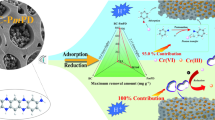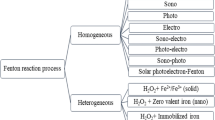Abstract
The removal of artificial sweetener saccharin (SAC) in aqueous solution by electrochemical advanced oxidation using electro-Fenton process was performed. Experiments were carried out in an undivided cylindrical glass cell with a carbon-felt cathode and a Pt or boron-doped diamond (BDD) anode. The removal of SAC by electrochemically generated hydroxyl radicals followed pseudo-first-order kinetics with both Pt and BDD anode. The absolute rate constant of the SAC hydroxylation reaction was determined for the first time using the competition kinetic method and found to be (1.85 ± 0.01) × 109 M−1 s−1. The comparative study of TOC removal efficiency during electro-Fenton treatment indicated a higher mineralization rate with BDD than Pt anode. The identification and evolution of short-chain carboxylic acids and inorganic ions formed during oxidation process were monitored by ion-exchange chromatography and ion chromatography, respectively. The assessment of toxicity of SAC and/or its reaction by-products during treatment was performed using Microtox® method based on the Vibrio fischeri bacteria luminescence inhibition. Results showed that the process was able to efficiently detoxify the treated solution.











Similar content being viewed by others
References
Assumpção MHMT, Medeiros RA, Madi A, Fatibello-Filho O (2008) Desenvolvimento de um procedimento biamperométrico para determinação de sacarina em produtos dietéticos. Quim Nov. 31:1743–1746
Boye B, Dieng MM, Brillas E (2002) Degradation of herbicide 4-chlorophenoxyacetic acid by advanced electrochemical oxidation methods. Environ Sci Technol 36:3030–3035
Brillas E, Martínez-Huitle CA (2015) Decontamination of wastewaters containing synthetic organic dyes by electrochemical methods. An updated review. Appl Catal B Environ 166:603–643
Brillas E, Sirés I, Arias C, Cabot PL, Centellas F, Rodríguez RM, Garrido JA (2005) Mineralization of paracetamol in aqueous medium by anodic oxidation with a boron-doped diamond electrode. Chemosphere 58:399–406
Brillas E, Sirés I, Oturan MA (2009) Electro-Fenton process and related electrochemical technologies based on Fenton’s reaction chemistry. Chem Rev 109:6570–6631
Buerge IJ, Buser H-R, Kahle M, Müller MD, Poiger T (2009) Ubiquitous occurrence of the artificial sweetener acesulfame in the aquatic environment: an ideal chemical marker of domestic wastewater in groundwater. Environ Sci Technol 43:4381–4385
Buerge IJ, Keller M, Buser H-R, Müller MD, Poiger T (2010) Saccharin and other artificial sweeteners in soils: estimated inputs from agriculture and households, degradation, and leaching to groundwater. Environ Sci Technol 45:615–621
Chattopadhyay S, Raychaudhuri U, Chakraborty R (2014) Artificial sweeteners—a review. J Food Sci Technol 51:611–621
De Laat J, Le TG (2006) Effects of chloride ions on the iron(III)-catalyzed decomposition of hydrogen peroxide and on the efficiency of the Fenton-like oxidation process. Appl Catal B Environ 66:137–146
de Moura DC, de Araújo CKC, Zanta CLPS, Salazar R, Martínez-Huitle CA (2014) Active chlorine species electrogenerated on Ti/Ru0.3Ti0.7O2 surface: electrochemical behavior, concentration determination and their application. J Electroanal Chem 731:145–152
Dirany A, Sirés I, Oturan N, Oturan MA (2010) Electrochemical abatement of the antibiotic sulfamethoxazole from water. Chemosphere 81:594–602
Dirany A, Sirés I, Oturan N, Özcan A, Oturan MA (2012) Electrochemical treatment of the antibiotic sulfachloropyridazine: kinetics, reaction pathways, and toxicity evolution. Environ Sci Technol 46:4074–4082
dos Santos EV, Saez C, Martinez-Huitle CA, Cañizares P, Rodrigo MA (2015) The role of particle size on the conductive diamond electrochemical oxidation of soil-washing effluent polluted with atrazine. Electroche Comm 55:26–29
Fahlberg C, Remsen I (1879) Ueber die oxydation des orthotoluolsulfamids. Ber Dtsch Chem Ges 12:469–473
Filho JC, Santini AO, Nasser ALM, Pezza HR, Eduardo de Oliveira J, Melios CB, Pezza L (2003) Potentiometric determination of saccharin in commercial artificial sweeteners using a silver electrode. Food Chem 83:297–301
Gan ZW, Sun HW, Feng BT, Wang RN, Zhang YW (2013) Occurrence of seven artificial sweeteners in the aquatic environment and precipitation of Tianjin, China. Water Res 47:4928–4937
Hammami S, Bellakhal N, Oturan N, Oturan MA, Dachraoui M (2008) Degradation of Acid Orange 7 by electrochemically generated •OH radicals in acidic aqueous medium using a boron-doped diamond or platinum anode: a mechanistic study. Chemosphere 73:678–684
Keen OS, Linden KG (2013) Re-engineering an artificial sweetener: transforming sucralose residuals in water via advanced oxidation. Environ Sci Technol 47:6799–6805
Kroger M, Meister K, Kava R (2006) Low-calorie sweeteners and other sugar substitutes: a review of the safety issues. Compre Rev Food Sci Food Saf 5:35–47
Lange F, Scheurer M, Brauch H-J (2012) Artificial sweeteners—a recently recognized class of emerging environmental contaminants: a review. Anal Bioanal Chem 403:2503–2518
Lin H, Zhang H, Wang X, Wang LG, Wu J (2014) Electro-Fenton removal of Orange II in a divided cell: Reaction mechanism, degradation pathway and toxicity evolution. Sep Purif Technol 122:533–540
Loaiza-Ambuludi S, Panizza M, Oturan N, Özcan A, Oturan MA (2013) Electro-Fenton degradation of anti-inflammatory drug ibuprofen in hydroorganic medium. J Electroanal Chem 702:31–36
Mawhinney DB, Young RB, Vanderford BJ, Borch T, Snyder SA (2011) Artificial sweetener sucralose in U.S. drinking water systems. Environ Sci Technol 45:8716–8722
Mhemdi A, Oturan MA, Oturan N, Abdelhédi R, Ammar S (2013) Electrochemical advanced oxidation of 2-chlorobenzoic acid using BDD or Pt anode and carbon felt cathode. J Electroanal Chem 709:111–117
Mousset E, Oturan N, van Hullebusch ED, Guibaud G, Esposito G, Oturan MA (2014a) Influence of solubilizing agents (cyclodextrin or surfactant) on phenanthrene degradation by electro-Fenton process—study of soil washing recycling possibilities and environmental impact. Water Res 48:306–316
Mousset E, Oturan N, Van Hullebusch ED, Guibaud G, Esposito G, Oturan MA (2014b) Treatment of synthetic soil washing solutions containing phenanthrene and cyclodextrin by electro-oxidation. Influence of anode materials on toxicity removal and biodegradability enhancement. Appl Catal B Environ 160–161:666–675
Nidheesh PV, Gandhimathi R (2012) Trends in electro-Fenton process for water and wastewater treatment: an overview. Desalination 299:1–15
Nidheesh PV, Gandhimathi R, Sanjini NS (2014) NaHCO3 enhanced Rhodamine B removal from aqueous solution by graphite–graphite electro Fenton system. Sep Purif Technol 132:568–576
Olvera-Vargas H, Oturan N, Aravindakumar CT, Sunil Paul MM, Sharma VK, Oturan MA (2014) Electro-oxidation of the Dye Azure B: kinetics, mechanism and by-products. Environ Sci Pollut Res 21:8379–8386
Oturan MA (2014) Electrochemical advanced oxidation technologies for removal of organic pollutants from water. Environ Sci Pollut Res 21:8333–8335
Oturan MA, Aaron JJ (2014) Advanced oxidation processes in water/wastewater treatment: principles and applications. A review. Crit Rev Environ Sci Technol 44:2577–2641
Oturan MA, Edelahi MC, Oturan N, El kacemi K, Aaron J-J (2010) Kinetics of oxidative degradation/mineralization pathways of the phenylurea herbicides diuron, monuron and fenuron in water during application of the electro-Fenton process. Appl Catal B Environ 97:82–89
Oturan N, Hamza M, Ammar S, Abdelhédi R, Oturan MA (2011) Oxidation/mineralization of 2-Nitrophenol in aqueous medium by electrochemical advanced oxidation processes using Pt/carbon-felt and BDD/carbon-felt cells. J Electroanal Chem 661:66–71
Oturan N, Brillas E, Oturan MA (2012) Unprecedented total mineralization of atrazine and cyanuric acid by anodic oxidation and electro-Fenton with a boron-doped diamond anode. Environ Chem Lett 10:165–170
Oturan N, Wu J, Zhang H, Sharma VK, Oturan MA (2013) Electrocatalytic destruction of the antibiotic tetracycline in aqueous medium by electrochemical advanced oxidation processes: effect of electrode materials. Appl Catal B Environ 140–141:92–97
Özcan A, Şahin Y, Koparal AS, Oturan MA (2008a) Degradation of picloram by the electro-Fenton process. J Hazard Mater 153:718–727
Özcan A, Şahin Y, Koparal AS, Oturan MA (2008b) Propham mineralization in aqueous medium by anodic oxidation using boron-doped diamond anode: influence of experimental parameters on degradation kinetics and mineralization efficiency. Water Res 42:2889–2898
Panizza M, Cerisola G (2009) Direct and mediated anodic oxidation of organic pollutants. Chem Rev 109:6541–6569
Qiang ZM, Chang J-H, Huang C-P (2003) Electrochemical regeneration of Fe2+ in Fenton oxidation processes. Water Res 37:1308–1319
Rodrigo, MA, Oturan, N, Oturan, MA (2014) Electrochemically assisted remediation of pesticides in soils and water: A review. Chem Rev 114:8720–8745
Scheurer M, Brauch H-J, Lange F (2009) Analysis and occurrence of seven artificial sweeteners in German waste water and surface water and in soil aquifer treatment (SAT). Anal Bioanal Chem 394:1585–1594
Sharma VK, Sohn M, Anquandah GAK, Nesnas N (2012) Kinetics of the oxidation of sucralose and related carbohydrates by ferrate(VI). Chemosphere 87:644–648
Sharma VK, Oturan M, Kim H (2014) Oxidation of artificial sweetener sucralose by advanced oxidation processes: a review. Environ Sci Pollut Res 21:8525–8533
Shukla S, Oturan MA (2015) Dye removal using electrochemistry and semiconductor oxide nanotubes. Environ Chem Lett 13:157–172
Sirés I, Garrido JA, Rodríguez RM, Brillas E, Oturan N, Oturan MA (2007) Catalytic behavior of the Fe3+/Fe2+ system in the electro-Fenton degradation of the antimicrobial chlorophene. Appl Catal B Environ 72:382–394
Sirés I, Brillas E, Oturan MA, Rodrigo MA, Panizza M (2014) Electrochemical advanced oxidation processes: today and tomorrow. a review. Environ Sci Pollut Res 21:8336–8367
Soh L, Connors KA, Brooks BW, Zimmerman J (2011) Fate of sucralose through environmental and water treatment processes and impact on plant indicator species. Environ Sci Technol 45:1363–1369
Toth JE, Rickman KA, Venter AR, Kiddle JJ, Mezyk SP (2012) Reaction kinetics and efficiencies for the hydroxyl and sulfate radical based oxidation of artificial sweeteners in water. J Phys Chem A 116:9819–9824
Tripathi M, Khanna SK, Das M (2006) Usage of saccharin in food products and its intake by the population of Lucknow, India. Food Addit Contam 23:1265–1275
Turabik M, Oturan N, Gözmen B, Oturan MA (2014) Efficient removal of insecticide “imidacloprid” from water by electrochemical advanced oxidation processes. Environ Sci Pollut Res 21:8387–8397
Van Stempvoort DR, Roy JW, Brown SJ, Bickerton G (2011) Artificial sweeteners as potential tracers in groundwater in urban environments. J Hydrol 401:126–133
Vasudevan S, Oturan M (2014) Electrochemistry: as cause and cure in water pollution—an overview. Environ Chem Lett 12:97–108
Wang JL, Xu LJ (2011) Advanced oxidation processes for wastewater treatment: formation of hydroxyl radical and application. Crit Rev Env Sci Technol 42:251–325
Xu Y, Lin ZY, Zhang H (2016) Mineralization of sucralose by UV-based advanced oxidation processes: UV/PDS versus UV/H2O2. Chem Eng J 285:392–401
Yahya MS, Oturan N, El Kacemi K, El Karbane M, Aravindakumar CT, Oturan MA (2014) Oxidative degradation study on antimicrobial agent ciprofloxacin by electro-Fenton process: kinetics and oxidation products. Chemosphere 117:447–454
Acknowledgments
LIN H. and ZHANG H. would like to acknowledge the financial support by Chinese Science Council (201306270179, 201306270100) and National Natural Science Foundation of China (Grant No 21547006).
Author information
Authors and Affiliations
Corresponding authors
Additional information
Responsible editor: Santiago V. Luis
Submitted to Environmental Science and Pollution Research for consideration.
Highlights
Artificial sweetener saccharin was first degraded by electro-Fenton process.
The effect of operating parameters on the degradation and mineralization was investigated.
The formed carboxylic acids during treatment were identified and quantified.
The change of toxicity during treatment was examined by using Microtox method.
Rights and permissions
About this article
Cite this article
Lin, H., Wu, J., Oturan, N. et al. Degradation of artificial sweetener saccharin in aqueous medium by electrochemically generated hydroxyl radicals. Environ Sci Pollut Res 23, 4442–4453 (2016). https://doi.org/10.1007/s11356-015-5633-x
Received:
Accepted:
Published:
Issue Date:
DOI: https://doi.org/10.1007/s11356-015-5633-x




